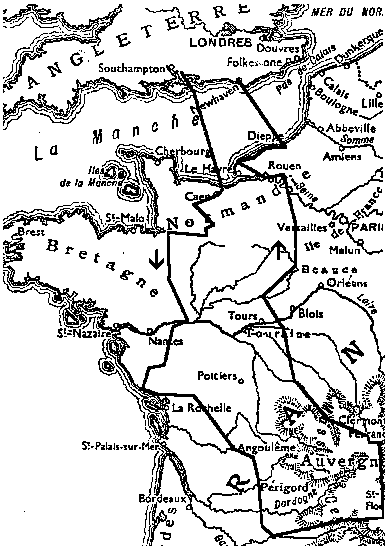 SECRET FRANCE
Some Pictures from a Journey
Douce France,
Cher pays de mon enfance,
Bercée de tendre insouciance,
Je t’ai gardée dans mon coeur.
Charles Trenet
SECRET FRANCE
Some Pictures from a Journey
Douce France,
Cher pays de mon enfance,
Bercée de tendre insouciance,
Je t’ai gardée dans mon coeur.
Charles TrenetSECRET FRANCE Some Pictures from a Journey Douce France, Cher pays de mon enfance, Bercée de tendre insouciance, Je t’ai gardée dans mon coeur. Charles Trenet
August, they say, is a pretty silly month in which to set off on a touring holiday in France. But back in 1989, it was the only time we were free; and with both children away at once for the first time ever, and a Silver Wedding to celebrate, what choice did we have? We bought a ferry ticket and some hotel vouchers from Brittany Ferries, and went off in search.
In search of what, precisely? Of an idea, a memory, a legend, in search of Trenet’s Douce France, la France Profonde, Secret France, undiscovered by the holiday trade, neglected by the new French; the France of country roads, of unawakened villages basking in the sun, of mountains, lake and forest.
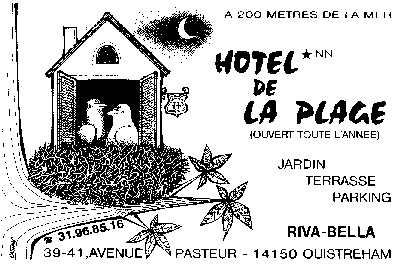
The Portsmouth-Caen ferry decanted us at Ouistreham in the late evening, and we spent the night just a few hundred yards away at the Hôtel de la Plage, the first (and one of the best) of many Logis de France on our journey.
Not least of the charms of the Hôtel de la Plage was the classic French breakfast, with excellent coffee, lots of milk, croissants, fresh bread and a choice of jam; quite the most perfect way to begin a day in France.
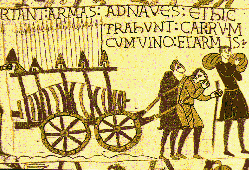
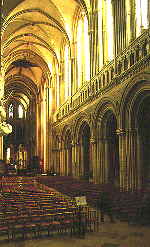
Our first morning’s travel took us inland to Bayeux. This was because I had never actually seen the famous tapestry, though I knew it well from books. June hired a machine which gave her a running commentary; I decided to manage without, and found myself translating the Latin for two Americans who had unwisely made the same decision. There is, however, much more to Bayeux than tapestry; lots of old houses, a splendid watermill, and a Cathedral in which every stone seems to be decorated. From Bayeux there is a choice of ways; West to Saint-Lô, Coutances and Granville, or South to Falaise and La Suisse Normande.
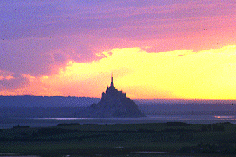 Our
goal for the night was Avranches, a town set on a hill and notable above all for
its views. In the daytime, go to the castle and look out from La Plate-forme;
but on a summer’s evening, park in the wide square in front of Notre-Dame and go
into the park. Here, amid the gorgeous flower-beds in the florid style beloved
of Norman gardeners, classical music plays softly through loudspeakers in the
trees, and a hillside terrace overlooks the Bay of Mont-Saint-Michel. The best
time of all is at twilight, when the island once called the Wonder of the West
is silhouetted against the gloaming sky. And already, we found, we had left the
crowds and the tourists behind; around us in the park, every voice was French,
the tones low and gentle in the golden dusk. The night was warm, with a little
breeze from the bay.
Our
goal for the night was Avranches, a town set on a hill and notable above all for
its views. In the daytime, go to the castle and look out from La Plate-forme;
but on a summer’s evening, park in the wide square in front of Notre-Dame and go
into the park. Here, amid the gorgeous flower-beds in the florid style beloved
of Norman gardeners, classical music plays softly through loudspeakers in the
trees, and a hillside terrace overlooks the Bay of Mont-Saint-Michel. The best
time of all is at twilight, when the island once called the Wonder of the West
is silhouetted against the gloaming sky. And already, we found, we had left the
crowds and the tourists behind; around us in the park, every voice was French,
the tones low and gentle in the golden dusk. The night was warm, with a little
breeze from the bay.
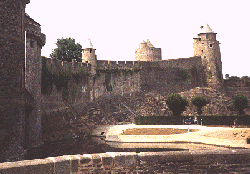
 We
spent the night at the Hôtel des Touristes at LeV - not a bad place for its one
star, but set at a noisy road junction. There were no croissants for breakfast.
On the borders of the ancient provinces there are always castles, protecting
each independent Dukedom from its neighbours. As we drove along the boundary
between Normandy and Brittany, we came in turn to Fougères, Vitré and
Châteaubriant. Fougères has the best castle (left), medieval and powerful, with
seventeen towers still standing, a labyrinth of streets and houses inside its
walls, a stream and two watermills. It is in Normandy, built to repel invading
Bretons. Vitré, a few miles down the road, is in Brittany. The town has kept its
medieval centre, with whole streets dating from the fourteenth and fifteenth
centuries. The houses (right) seem to be built of a lighter stone than the
castle.
We
spent the night at the Hôtel des Touristes at LeV - not a bad place for its one
star, but set at a noisy road junction. There were no croissants for breakfast.
On the borders of the ancient provinces there are always castles, protecting
each independent Dukedom from its neighbours. As we drove along the boundary
between Normandy and Brittany, we came in turn to Fougères, Vitré and
Châteaubriant. Fougères has the best castle (left), medieval and powerful, with
seventeen towers still standing, a labyrinth of streets and houses inside its
walls, a stream and two watermills. It is in Normandy, built to repel invading
Bretons. Vitré, a few miles down the road, is in Brittany. The town has kept its
medieval centre, with whole streets dating from the fourteenth and fifteenth
centuries. The houses (right) seem to be built of a lighter stone than the
castle.
The castle itself was built, of course, to keep back invading Normans. It is triangular, one of the sides being made up by a Town Hall built since the war and perfectly in keeping with the rest of the building. The stone is Breton granite, yellowed by centuries of lichen.
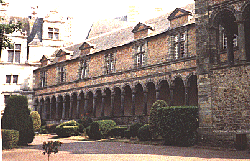 Châteaubriant
is doubtless a very fine town. It stands on the borders of Normandy and Anjou,
and the first view of its castle reflects already Angevin castles of the Loire.
But we didn’t like it. June didn’t like it because the castle (left) is half
medieval and half Renaissance, pairing windowless granite with mullioned fantasy
in limestone, and June liked buildings to make up their minds and be one thing
or the other; and I don’t like Châteaubriant because, while we were exploring
the castle, the local vandals took a sharp instrument to the bonnet of our car.
Châteaubriant
is doubtless a very fine town. It stands on the borders of Normandy and Anjou,
and the first view of its castle reflects already Angevin castles of the Loire.
But we didn’t like it. June didn’t like it because the castle (left) is half
medieval and half Renaissance, pairing windowless granite with mullioned fantasy
in limestone, and June liked buildings to make up their minds and be one thing
or the other; and I don’t like Châteaubriant because, while we were exploring
the castle, the local vandals took a sharp instrument to the bonnet of our car.
At some point in a journey like this, one has to cross the Loire. One of the best places to do this is near Angers. We spent the night North of the river at Candé, in the Hôtel des Tonnelles. This hotel was weird. It had six bedrooms, round the corner in the next street from the entrance, and approached by a tunnel which started from behind the bar. At the end of the tunnel, you go upstairs, through an assembly room, and onto another landing. The rooms are very cheap and very basic. Dinner, though, was cheap, well presented, fresh and appetising; but breakfast was terrible; we went straight to a café and bought another.
Angers is a fine, prosperous town set on a hill above the river Maine, with a splendid park, an over-restored Cathedral and some fine museums. Some of the streets in the centre are picturesque, and the whole place looks as if it has just been thoroughly scrubbed. We chose, however, to cross the river a little way downstream.
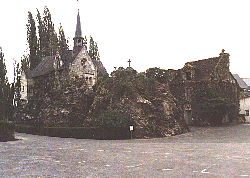
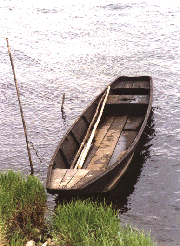 The
island of Béhuard consists essentially of a bank of sand which has built up
round a rock in the middle of the Loire, a few miles downstream from Angers.
Louis XI, saved from drowning in the fourteenth century, built a chapel on the
rock (left). When the Loire floods in the occasional wet spring, the chapel
remains clear of the water while the rest of the island floods and the
inhabitants accept the hospitality of the mainland village of Savennières.
Presumably they travel there in the traditional flat-bottomed Loire punts
(right). Once across the Loire, we made for the Atlantic coast, to spend a night
at the tiny seaside village of Saint-Vincent-sur-Jard, where Georges Clémenceau
used to spend his summers.
The
island of Béhuard consists essentially of a bank of sand which has built up
round a rock in the middle of the Loire, a few miles downstream from Angers.
Louis XI, saved from drowning in the fourteenth century, built a chapel on the
rock (left). When the Loire floods in the occasional wet spring, the chapel
remains clear of the water while the rest of the island floods and the
inhabitants accept the hospitality of the mainland village of Savennières.
Presumably they travel there in the traditional flat-bottomed Loire punts
(right). Once across the Loire, we made for the Atlantic coast, to spend a night
at the tiny seaside village of Saint-Vincent-sur-Jard, where Georges Clémenceau
used to spend his summers.
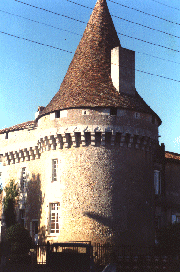
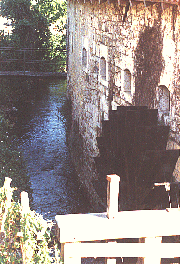 After
a night at the Hôtel de l’Océan (excellent but not cheap) we moved on through
Angoulême and drove all day deeper and deeper into the lush and tranquil heart
of France. In the evening we came to Javerlhac and the Auberge des Tilleuls.
After
a night at the Hôtel de l’Océan (excellent but not cheap) we moved on through
Angoulême and drove all day deeper and deeper into the lush and tranquil heart
of France. In the evening we came to Javerlhac and the Auberge des Tilleuls.
Javerlhac is the very model of a French village, with its tiny château (left), and dainty tower and mill (right) alongside the little river Bandiat. This is sweetest France, surrounded by mile after mile of scented hills.
And then, perfection.
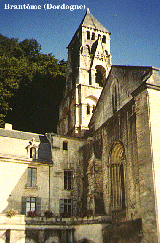
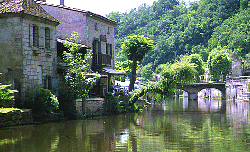
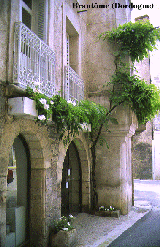
Just when we thought nothing could be an improvement on Javerlhac, we came down, in an early morning after an excellent breakfast, to Brantôme. Twenty thousand years ago there were people living here in caves hollowed out of the cliffs along the river Dronne. Twelve hundred years ago Charlemagne – in person – founded an Abbey here. The monks diverted the river and made an island, on which people built little houses with thick white walls and soft red roofs. And that is the whole story. Nothing has changed, nothing has happened since. There are still houses cut into the cliffs. There is water and willow trees, silence and slow time. Visitors come and are swallowed up. Only the bell on the abbey church, one of the oldest bells in France, punctuates the dream. If heaven is like this, I hope I deserve it.
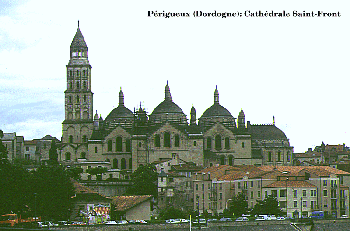 After
Brantôme we came to Périgueux, a town half medieval and half Roman, whose
Cathedral (left) was restored by Abadie, the architect of the Sacré-Coeur. South
of there, approaching the river Lot, the heat became too much for us. ‘That’s
enough’, said June, ‘Take me to the mountains.’
After
Brantôme we came to Périgueux, a town half medieval and half Roman, whose
Cathedral (left) was restored by Abadie, the architect of the Sacré-Coeur. South
of there, approaching the river Lot, the heat became too much for us. ‘That’s
enough’, said June, ‘Take me to the mountains.’
So we turned East through Aurillac and Murat, over the Col du Lioran and down into the Auvergne, where we found the gorges of the Truyère and the Hôtel du Viaduc at Garabit.
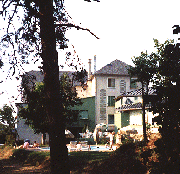 If
I had to choose a single Hotel in the whole of France, this would be the one.
Perched 400 feet above the lake of Grandval, it has two stars and deserves more,
but remains quite ridiculously cheap. The views are amazing, and the food is
sensational. I could live the rest of my life on the hors d’oeuvre trolley
alone. And the surrounding countryside is what we had come all this way to find.
The lake itself, a widening of the Truyère river held back by the Barrage de
Grandval, snakes through deep gorges and can be visited by boat.
If
I had to choose a single Hotel in the whole of France, this would be the one.
Perched 400 feet above the lake of Grandval, it has two stars and deserves more,
but remains quite ridiculously cheap. The views are amazing, and the food is
sensational. I could live the rest of my life on the hors d’oeuvre trolley
alone. And the surrounding countryside is what we had come all this way to find.
The lake itself, a widening of the Truyère river held back by the Barrage de
Grandval, snakes through deep gorges and can be visited by boat.
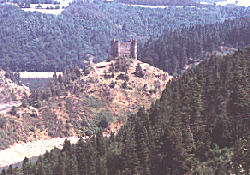
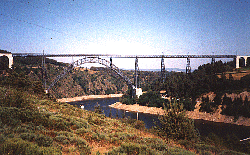 On
a high rock jutting out into the lake stands the romantic Château d’Alleuze, and
over the deepest gorge arches the Viaduc de Garabit, the spectacular edifice on
which the young Gustave Eiffel elaborated the method of construction in iron
lace which was later to provide Paris with a more prominent but considerably
less useful monument.
On
a high rock jutting out into the lake stands the romantic Château d’Alleuze, and
over the deepest gorge arches the Viaduc de Garabit, the spectacular edifice on
which the young Gustave Eiffel elaborated the method of construction in iron
lace which was later to provide Paris with a more prominent but considerably
less useful monument.
One of the best things to happen to rural France in the past few years has been the development of the Écomusée idea. An Écomusée is a small, local Museum of popular arts and traditions, usually housed in a number of different sites dotted about a region.
 The
Écomusée de la Margeride has five sites, including a forge, a manor house and a
village school, all frozen in time exactly as they were at the turn of the
century. Through the summer months, enthusiastic students staff the buildings.
You can buy tickets for individual sites, or a single ticket for them all, and
spend an hour, a day or a week getting to know your great-grandparents. The
house of which I’m obstructing your view on the left is
La Maison du Paysan, a long,
low mellow stone house and barn built for a peasant farmer at the end of the
last century. A button in each room switches on a tape recording which describes
the articles to be seen there and the way they were used. We found the place
totally fascinating, and an excellent use for a series of buildings which
otherwise, left behind by the drift to the towns, might simply have been allowed
to crumble into ruins.
The
Écomusée de la Margeride has five sites, including a forge, a manor house and a
village school, all frozen in time exactly as they were at the turn of the
century. Through the summer months, enthusiastic students staff the buildings.
You can buy tickets for individual sites, or a single ticket for them all, and
spend an hour, a day or a week getting to know your great-grandparents. The
house of which I’m obstructing your view on the left is
La Maison du Paysan, a long,
low mellow stone house and barn built for a peasant farmer at the end of the
last century. A button in each room switches on a tape recording which describes
the articles to be seen there and the way they were used. We found the place
totally fascinating, and an excellent use for a series of buildings which
otherwise, left behind by the drift to the towns, might simply have been allowed
to crumble into ruins.
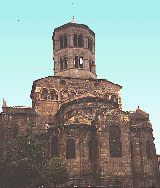 After
three nights at the Hôtel du Viaduc, we dragged ourselves away and turned north.
We passed through Saint-Flour, crouched on its hilltop, and Issoire with its
tiny cathedral in Auvergne romanesque (left), little round chapels clinging to
its apse like a litter of piglets, and came to Clermont-Ferrand in time for
lunch.
After
three nights at the Hôtel du Viaduc, we dragged ourselves away and turned north.
We passed through Saint-Flour, crouched on its hilltop, and Issoire with its
tiny cathedral in Auvergne romanesque (left), little round chapels clinging to
its apse like a litter of piglets, and came to Clermont-Ferrand in time for
lunch.
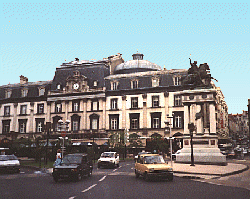 It
was here (right) that we met all those years ago, in the Place de Jaude in front
of the statue of Vercingetorix. He, of course, was the Gaulish warrior who
defied Caesar, defeating the Romans Gergovia just outside the town, only to be
crushed a year later at Alésia. The statue (known to the locals as Papa Gaulois)
is by Bartholdi, the man who did the Statue of Liberty. Clermont is a town
unjustly neglected by visitors. Set in the spectacular National Park of the
Auvergne volcanoes (all happily extinct), it offers splendid views and a wealth
of medieval houses and churches, from the romanesque of Notre Dame-du-Port to
the Gothic of its unusual black cathedral, built of volcanic rock from Volvic.
The old district of Montferrand is especially worth a visit. On the other hand,
we found that the Brasserie where as students we used spend our evenings is now
a burger bar.
It
was here (right) that we met all those years ago, in the Place de Jaude in front
of the statue of Vercingetorix. He, of course, was the Gaulish warrior who
defied Caesar, defeating the Romans Gergovia just outside the town, only to be
crushed a year later at Alésia. The statue (known to the locals as Papa Gaulois)
is by Bartholdi, the man who did the Statue of Liberty. Clermont is a town
unjustly neglected by visitors. Set in the spectacular National Park of the
Auvergne volcanoes (all happily extinct), it offers splendid views and a wealth
of medieval houses and churches, from the romanesque of Notre Dame-du-Port to
the Gothic of its unusual black cathedral, built of volcanic rock from Volvic.
The old district of Montferrand is especially worth a visit. On the other hand,
we found that the Brasserie where as students we used spend our evenings is now
a burger bar.
 We
spent the next night at the Hôtel Belle Vue at Les Ancizes; dinner and breakfast
on a terrace overlooking a lake. Then in the early morning we went up to the
Viaduc des Fades (left). We had thought Eiffel’s viaduct spectacular, but this
is breathtaking; half a mile across, 500 feet high. The engineer here was
Vialard, who deserves to be remembered. The river above and left is the Sioule,
but in appearance it could be any of a dozen flowing out of the high Plateau de
Millevaches to water the centre of France: Alagnon, Creuse, Vienne, Indre,
Corrèze. Millevaches, by the way, doesn’t mean a thousand cows; it’s based on a
Celtic word and means a thousand springs. All the rivers have forested gorges,
most are dammed into a series of lakes. Every turn of the road brings new
delight.
We
spent the next night at the Hôtel Belle Vue at Les Ancizes; dinner and breakfast
on a terrace overlooking a lake. Then in the early morning we went up to the
Viaduc des Fades (left). We had thought Eiffel’s viaduct spectacular, but this
is breathtaking; half a mile across, 500 feet high. The engineer here was
Vialard, who deserves to be remembered. The river above and left is the Sioule,
but in appearance it could be any of a dozen flowing out of the high Plateau de
Millevaches to water the centre of France: Alagnon, Creuse, Vienne, Indre,
Corrèze. Millevaches, by the way, doesn’t mean a thousand cows; it’s based on a
Celtic word and means a thousand springs. All the rivers have forested gorges,
most are dammed into a series of lakes. Every turn of the road brings new
delight.
 We
stopped for lunch at Aubusson. Here is a town famous for its tapestries, full of
tapestry museums and tapestry factories and tapestry shops (all of them closed
for lunch) – and apparently nothing else. We ate outdoors and were plagued by
wasps. Infinitely more pleasant was our next stop at Argenton-sur-Creuse
(right). This delightful little town straddles the Creuse with an old stone
bridge and two water-mills. A higgledy-piggle of medieval houses overhangs the
river with eaves and balconies and window-boxes, and nearby is a perfect little
square straight out of a French toytown, with Mairie, Gendarmerie, Poste and
École all in their appointed places. The castle was demolished centuries ago,
but its chapel remains on a hill overlooking the town, its steeple decorated
with a huge and florid golden Virgin and Child.
We
stopped for lunch at Aubusson. Here is a town famous for its tapestries, full of
tapestry museums and tapestry factories and tapestry shops (all of them closed
for lunch) – and apparently nothing else. We ate outdoors and were plagued by
wasps. Infinitely more pleasant was our next stop at Argenton-sur-Creuse
(right). This delightful little town straddles the Creuse with an old stone
bridge and two water-mills. A higgledy-piggle of medieval houses overhangs the
river with eaves and balconies and window-boxes, and nearby is a perfect little
square straight out of a French toytown, with Mairie, Gendarmerie, Poste and
École all in their appointed places. The castle was demolished centuries ago,
but its chapel remains on a hill overlooking the town, its steeple decorated
with a huge and florid golden Virgin and Child.
It was Silver Wedding time, so just for a while we went back to the beaten track and braved the tourist swarms for a visit to Chenonceaux, which was where I proposed (and she accepted) in the first place.
After Chenonceaux we crossed the Loire at Amboise (stopping for a light lunch at a Salon de Thé which sells probably the second-best pâtisserie in France), and drove on through the gentler countryside of the garden of France to Vendôme on the confusingly-named river Loir.
 Vendôme
is a charming town, with old quarters, a castle and a Town Gate and a good
pedestrianised centre. Among a number of medieval churches, its chief glory is
the Église Abbatiale de la Trinité, the finest flower of the Flamboyant gothic,
the last and daintiest development of the style. It had just been restored at a
cost of 40 million francs; a sum not raised as in England by begging the charity
of visitors, but contributed by local and national government as a natural and
proper preservation of national heritage. If this is what disestablishment does
for churches, I’m in favour. The doorway in particular (left) is a marvel, the
door merely another opening in a vast wall of glass, a thin and permeable veil
between the town of Vendôme and the Kingdom of God.
Vendôme
is a charming town, with old quarters, a castle and a Town Gate and a good
pedestrianised centre. Among a number of medieval churches, its chief glory is
the Église Abbatiale de la Trinité, the finest flower of the Flamboyant gothic,
the last and daintiest development of the style. It had just been restored at a
cost of 40 million francs; a sum not raised as in England by begging the charity
of visitors, but contributed by local and national government as a natural and
proper preservation of national heritage. If this is what disestablishment does
for churches, I’m in favour. The doorway in particular (left) is a marvel, the
door merely another opening in a vast wall of glass, a thin and permeable veil
between the town of Vendôme and the Kingdom of God.
 We
spent the night in one of those American-style hotels which are beginning to
infest Europe; impersonal and soulless, with satellite TV in every room and
bland food in tiny portions. It was a relief to drive on to Le Mans, where the
East end of the cathedral (right) cascades down a hillside in a vast exuberance
of buttresses and pinnacles. The nave, on the other hand, remains Romanesque,
lower and darker, with small round-headed windows filled with exquisite glass.
The medieval streets of Le Mans are well worth a visit; when we passed through,
they were being used as a set for the Film of Cyrano de Bergerac. They were old
already in Cyrano’s time, the early eighteenth century.
We
spent the night in one of those American-style hotels which are beginning to
infest Europe; impersonal and soulless, with satellite TV in every room and
bland food in tiny portions. It was a relief to drive on to Le Mans, where the
East end of the cathedral (right) cascades down a hillside in a vast exuberance
of buttresses and pinnacles. The nave, on the other hand, remains Romanesque,
lower and darker, with small round-headed windows filled with exquisite glass.
The medieval streets of Le Mans are well worth a visit; when we passed through,
they were being used as a set for the Film of Cyrano de Bergerac. They were old
already in Cyrano’s time, the early eighteenth century.
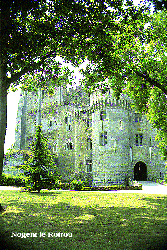 North
and East of Le Mans, we are back in Secret France. The region known as Le Perche
is most famous for its heavy horses, the gentle grey Percheron. Half the Perche
belongs to the Loire provinces, half to Normandy. Capital of the Norman half is
Nogent-le-Rotrou, whose half-ruined Château Saint-Jean (left) – one of a very
few fortresses named after a saint - looks down from a steep hilltop. The town,
though charming, is not particularly ancient. It has good shops, though, and a
splendid clothes market on Saturdays. Other towns of the Perche are more
picturesque; Mortagne-au-Perche, for example, Bellême or Verneuil. Best of all
are the villages, often on hilltops, self-contained and ancient.
North
and East of Le Mans, we are back in Secret France. The region known as Le Perche
is most famous for its heavy horses, the gentle grey Percheron. Half the Perche
belongs to the Loire provinces, half to Normandy. Capital of the Norman half is
Nogent-le-Rotrou, whose half-ruined Château Saint-Jean (left) – one of a very
few fortresses named after a saint - looks down from a steep hilltop. The town,
though charming, is not particularly ancient. It has good shops, though, and a
splendid clothes market on Saturdays. Other towns of the Perche are more
picturesque; Mortagne-au-Perche, for example, Bellême or Verneuil. Best of all
are the villages, often on hilltops, self-contained and ancient.
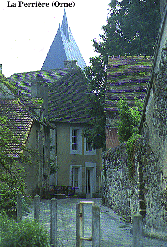 La
Perrière, not far from Nogent (right), is one of the best, and the local
historical society has signposted and printed leaflets for an hour’s walk among
the cottages and orchards, punctuated with wide, distant, hazy views. The whole
of Southern Normandy is a series of unexplored delights, from the Gorges of the
Vire to the borders of the Dunois near Châteaudun. It is rolling country, like
the centre but greener. You can drive all day along little winding empty roads,
finding new delights round every corner, under a wide, lark-encrusted sky. In
June the fields are full of poppies; in August many are filled with the surprise
of sunflowers, or the soft, lazy, long-eyelashed Norman cows which wear bells
round their necks because, so they say, their horns don’t work.
La
Perrière, not far from Nogent (right), is one of the best, and the local
historical society has signposted and printed leaflets for an hour’s walk among
the cottages and orchards, punctuated with wide, distant, hazy views. The whole
of Southern Normandy is a series of unexplored delights, from the Gorges of the
Vire to the borders of the Dunois near Châteaudun. It is rolling country, like
the centre but greener. You can drive all day along little winding empty roads,
finding new delights round every corner, under a wide, lark-encrusted sky. In
June the fields are full of poppies; in August many are filled with the surprise
of sunflowers, or the soft, lazy, long-eyelashed Norman cows which wear bells
round their necks because, so they say, their horns don’t work.
Normandy, when you think about it, could function perfectly well as an independent country. When William the Conqueror took England, he still thought of himself as Duke of Normandy because Normandy, after all, was big in itself. It stretches from Le Tréport in the North to Nogent and the Perche, and in the West from Fougères northwards; a third the size of England, but with a population of only three million. It has four channel ports – Dieppe, le Havre, Caen and Cherbourg – each of them half an hour’s drive from wide open spaces. This drive across the country between Loire and Seine, from Le Mans to Rouen passes by wonderful places; ancient abbeys, glassy streams, lush meadows, quaint villages. The day passed in a Summer dream.
 Rouen
is the capital of Normandy. Joan of Arc was burnt there because Normandy
belonged to the King of England. The Cathedral (left), with its lantern tower,
is the greatest glory of the Norman gothic. Another glory is the finest
pâtisserie in all France. Some of the old streets are well known; but many are
hardly ever visited. The authorities were halfway through their programme of
restoring Rouen’s mediaeval houses, and so far they had done four hundred.
Rouen’s prosperity was always due to its bridge, the nearest to the sea on the
river Seine. In recent years, however, three new bridges have been built. The
Pont de Normandie at Le Havre is the latest, one of the world’s longest
cable-stay bridges, just as the Pont de Tancarville was in its day one of the
longest suspension bridges. My favourite is the high, elegant Pont de Brotonne,
which has provided access to the Brotonne peninsula, for centuries cut off from
the world in a loop of the great river. The Forest of Brotonne is now a National
Park, and it has a particularly attractive Écomusée, with an old bakery and a
clog-maker’s workshop at La Haye de Routot, a windmill at Hautot, and a Craft
Museum, La Maison des Métiers at Bourneville.
Rouen
is the capital of Normandy. Joan of Arc was burnt there because Normandy
belonged to the King of England. The Cathedral (left), with its lantern tower,
is the greatest glory of the Norman gothic. Another glory is the finest
pâtisserie in all France. Some of the old streets are well known; but many are
hardly ever visited. The authorities were halfway through their programme of
restoring Rouen’s mediaeval houses, and so far they had done four hundred.
Rouen’s prosperity was always due to its bridge, the nearest to the sea on the
river Seine. In recent years, however, three new bridges have been built. The
Pont de Normandie at Le Havre is the latest, one of the world’s longest
cable-stay bridges, just as the Pont de Tancarville was in its day one of the
longest suspension bridges. My favourite is the high, elegant Pont de Brotonne,
which has provided access to the Brotonne peninsula, for centuries cut off from
the world in a loop of the great river. The Forest of Brotonne is now a National
Park, and it has a particularly attractive Écomusée, with an old bakery and a
clog-maker’s workshop at La Haye de Routot, a windmill at Hautot, and a Craft
Museum, La Maison des Métiers at Bourneville.
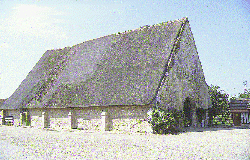 Privately
owned, but open in the same way, is the Tithe Barn (right) at Heurteauville,
just across the river from the ruined abbey of Jumièges. In the late summer an
apple festival is held in the barn, for Brotonne is a land of orchards.
Half-timbered , thatched cottages are the rule rather than the exception in
Brotonne, and a series of ferries all round the peninsula join this hidden
country to the ‘mainland’. We cross the Seine by the Pont de Brotonne at
Caudebec-en-Caux, whose name reminds us that we are once again in the chalk
country of the Channel coast.
Privately
owned, but open in the same way, is the Tithe Barn (right) at Heurteauville,
just across the river from the ruined abbey of Jumièges. In the late summer an
apple festival is held in the barn, for Brotonne is a land of orchards.
Half-timbered , thatched cottages are the rule rather than the exception in
Brotonne, and a series of ferries all round the peninsula join this hidden
country to the ‘mainland’. We cross the Seine by the Pont de Brotonne at
Caudebec-en-Caux, whose name reminds us that we are once again in the chalk
country of the Channel coast.
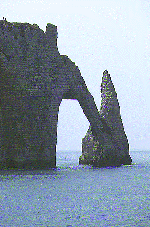 A
pleasant little road takes us North and West to Etretat (left), its spiky,
striped cliffs beloved of Impressionist painters, for a final day’s drive along
the coastline. The cliffs rise to above 300 feet in places, dipping for every
river valley to enclose a tiny fishing village or an ancient port. At Fécamp,
once the capital of the French cod-fishing industry, the museum remembers the
men who went out to the Grand Banks of Newfoundland for six months at a time.
There is an abbey church there, too, and the amazing Palais Bénédictine, built
in the 19th century to conceal the factory where the liqueur is made.
A
pleasant little road takes us North and West to Etretat (left), its spiky,
striped cliffs beloved of Impressionist painters, for a final day’s drive along
the coastline. The cliffs rise to above 300 feet in places, dipping for every
river valley to enclose a tiny fishing village or an ancient port. At Fécamp,
once the capital of the French cod-fishing industry, the museum remembers the
men who went out to the Grand Banks of Newfoundland for six months at a time.
There is an abbey church there, too, and the amazing Palais Bénédictine, built
in the 19th century to conceal the factory where the liqueur is made.
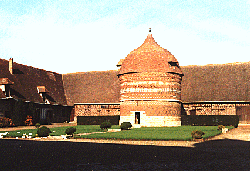 North
of Fécamp, the list of little coastal towns reads like a litany:
Saint-Pierre-en-Port, Dalles, Veulettes, Saint-Valéry-en-Caux, Veules-les-Roses,
Sotteville, Saint-Aubin, Quiberville, Sainte-Marguerite, Vastérival,
Varengeville. At Varengeville, on top of the highest of the cliffs, is the
charming Manoir d’Ango. Jehan Ango was an armchair pirate. Without moving from
Dieppe, he made a vast fortune in the sixteenth century from sending out ships
to prey on the Portuguese in the Caribbean. Four hundred of their ships he
captured, before the King of France spoiled it all by signing a peace treaty.
With his accumulated loot, Ango built his manor-house round a wide courtyard.
The vast dovecote (right) was a sign of his rank; only the Lord of the Manor was
allowed to keep pigeons, which feed on other people’s corn. It was a form of
taxation. Ango’s pigeons brought him messages from his ships, while the dovecote
served also as lighthouse and lookout tower. Three hundred feet above the sea,
the North side of the courtyard was left open until a nineteenth-century tenant
built a row of barns which now obscure the view. Inside the dovecote, a ladder
attached to a revolving beam gives access to each of the thousands of
pigeon-holes in the walls, so that the Lord’s servants could gather eggs and
young birds for the manorial table. The Manoir d’Ango is private, but for a
small fee you will be allowed to wander round and admire the pattern and texture
of its walls, made of white chalk and black flint from the cliffs, interspersed
with soft red brick. In the courtyard (below) an open gallery runs below the
great hall, unchanged since Ango’s time; or you can walk round the blind,
thick-walled outside of the building to admire the stupendous view from the
clifftop.
North
of Fécamp, the list of little coastal towns reads like a litany:
Saint-Pierre-en-Port, Dalles, Veulettes, Saint-Valéry-en-Caux, Veules-les-Roses,
Sotteville, Saint-Aubin, Quiberville, Sainte-Marguerite, Vastérival,
Varengeville. At Varengeville, on top of the highest of the cliffs, is the
charming Manoir d’Ango. Jehan Ango was an armchair pirate. Without moving from
Dieppe, he made a vast fortune in the sixteenth century from sending out ships
to prey on the Portuguese in the Caribbean. Four hundred of their ships he
captured, before the King of France spoiled it all by signing a peace treaty.
With his accumulated loot, Ango built his manor-house round a wide courtyard.
The vast dovecote (right) was a sign of his rank; only the Lord of the Manor was
allowed to keep pigeons, which feed on other people’s corn. It was a form of
taxation. Ango’s pigeons brought him messages from his ships, while the dovecote
served also as lighthouse and lookout tower. Three hundred feet above the sea,
the North side of the courtyard was left open until a nineteenth-century tenant
built a row of barns which now obscure the view. Inside the dovecote, a ladder
attached to a revolving beam gives access to each of the thousands of
pigeon-holes in the walls, so that the Lord’s servants could gather eggs and
young birds for the manorial table. The Manoir d’Ango is private, but for a
small fee you will be allowed to wander round and admire the pattern and texture
of its walls, made of white chalk and black flint from the cliffs, interspersed
with soft red brick. In the courtyard (below) an open gallery runs below the
great hall, unchanged since Ango’s time; or you can walk round the blind,
thick-walled outside of the building to admire the stupendous view from the
clifftop.
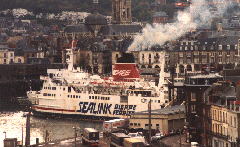
From Varengeville it is only a step to the most interesting of all channel ports, Dieppe, a place worth a week’s visit in its own right. The town, originally brought to prominence by its position on a direct line between London and Paris, is a treasure-house of good things. There is a castle and a gothic church in a maze of old streets full of charming corners. Twice a day until recently the car ferry would sail into the very heart town, and turn spectacularly round in a space where the length of the boat was almost exactly the width of the harbour (left). Fishing-boats, tugs and coasters bustle about in the three docks, and high cliffs to North and South offer splendid views over the town and coastline. The countryside around is a garden of delights, while the long, pebbly beach (right) also repays careful attention.
Some details for your information
We used Logis de France for our accommodation. These are in general family-run hotels with one or two stars, personal service and a country atmosphere. All are clean and offer basic comforts at an absurdly low price - usually about half the price of an English motel or Lodge, even in rooms with private bath or shower. Nearly all serve meals, often to an extremely high standard. Breakfast, however, can be a disappointment, and croissants are not usually part of the basic deal. As early morning is the best and quietest time for exploration, it can be a good idea to get on the road before breakfast and eat at a wayside café. Even in August, as long as you keep; away from tourist traps, you can book a hotel room on the day without much problem. We made a habit of telephoning the next hotel from our breakfast stop, so that if it was full we could book an alternative. Only in the Loire valley did we have to try more than two. If you want to simplify matters, Brittany Ferries will supply Vouchers, each worth a night’s stay in selected logis, along with a map and a short list. Otherwise, the full list of Logis can be obtained from bookshops or from the French Government Tourist Office at 178 Piccadilly, London.
Our favourite hotels on the trip were:
Hôtel de la Plage, 39-41 Avenue Pasteur, 14150 Ouistreham, Tel. 31 96 85 16:
Hôtel Saint- Pierre, Rue de la Libération, 61150 Rânes (in the Suisse Normande), Tel. 33 39 75 14.
Hôtel-Restaurant de l’0céan, 85520 Saint-Vincent-sur-jard Tel. 52 33 40 4
Auberge des Tilleuls, 24300 Javerlhac (Mme. Sansarlat) Tel. 53 56 30 12
Hotel du Viaduc (Alain Albuisson), 15390 Garabit Tel. 71 23 43 20
Hôtel Belle-Vue, Pont du Bouchet, 63770 Les Ancizes Tel. 73 86 80 39.